ISSN ONLINE(2319-8753)PRINT(2347-6710)
ISSN ONLINE(2319-8753)PRINT(2347-6710)
Veerendra M G1, Dr. Anil Kumar C2
|
| Related article at Pubmed, Scholar Google |
Visit for more related articles at International Journal of Innovative Research in Science, Engineering and Technology
This paper presents the synthesis of CuO-ZnO Mixed Metal Oxide (MMO) Nanoparticles by Co- Precipitation method. The structural and chemical characterizations of MMO were performed by Scanning Electron Microscope (SEM), X-Ray Diffraction (XRD) and Energy Dispersive Spectrometry (EDS). The size of CuO-ZnO nanoparticles determined by analysis of the X-ray diffraction peaks according to the Debye–Scherrer equation and found to be 18 to 30nm. Synthesized nanoparticles dispersed in SAE 20W50 oil at different concentrations of 0.5%, 1.0% and 2.0%wt using a Sonicator. Wear properties were evaluated using pin on disc tester. The weared pin surfaces analysed for scar diameter by SEM. The Wear Scar Diameter (WSD) decreases with increase in nanoparticle concentration in SAE 20W50. The Nanolubricant shows better performance of Co-efficient Of Friction (COF) with 1.0%wt.
Keywords |
| CuO-ZnO, Mixed MetalOxide (MMO),Co-efficient Of Friction(COF), Wear Scar Diameter (WSD), Nanolubricant. |
INTRODUCTION |
| Wear and surface damage caused by thefriction in moving parts can be reduced by Anti-Wear (AW) additives. These tend to be sulphur, chlorine and phosphorous containing compounds designed to react chemically with the metal surfaces, forming easily sheared layers of sulphides, chlorines or phosphides, and thereby preventing severe wear and seizure [1]. Recent advances and success in chemistry and technology of nano-organic particles with nanosize have provided the possibility of making different metallic oxides. During the past few years, the attention for producing and application of colloid nano-organic particles due to their unique properties such as optical, catalytic, semiconductor, magnetic, and anti-friction properties is continuously developed [2]. |
| The tribological properties of TiO2 [3–5], LaF3 [6], Graphite [7], Polytetrafluoroethylene (PTFE) [8], MoS2 [9], La(OH)3 [10], PbS [11], Lanthanum Borate [12], Titanium Borate [13], Zinc Borate [14], Ferrous Borate [15], Ni[16], CaCO3 [17] and ZnO [18] nanoparticles used as additives in lubricant have been investigated. Results show that they can deposit on the rubbing surface and improve the tribological properties of the base oil. Micron particles of certain hardness have also been reported to lead to abrasive friction [19]. |
| Copper oxide nanoparticles with a diameter of 10–40 nm have also been tested recently as an additive in cutting fluids [20]. Transfer and adhesion of the micellar particles accelerated surface modification, self-reducing and forming of a fine copper tribo-film that reduced the coefficient of friction, the direct contact between the cutting tool and the workpiece, the temperature in the cutting zone and hence tool wear. |
| Co-precipitation method adopted for the synthesis ofCuO-Zno Mixed Metal Oxide nanoparticles. SEM, XRD and EDS are used for characterization of nanoparticles. A pin on disc tester is used to study the wear properties of CuO-ZnO dispersed in lubricant. |
RELATED WORK |
| A simple coprecipitation technique was successfully applied for the preparation of pure ultrafine single phase, ZnNb2O6 (ZN). Ammonium hydroxide was used to precipitate Zn2+ and Nb5+cations as hydroxides simultaneously. This precursor on heating at 750°C, produced ZN powders. For comparison, ZN powders were also prepared by the traditional solid state method. The phase contents and lattice parameters were studied by the powder X-ray diffraction (XRD). Particle size and morphology were studied by transmission electron spectroscopy (TEM). For preparing ZnNb2O6, niobium (V) oxide, zinc nitrate and liquid ammonia were used as starting materials, and all were of AR grade (LOBA chemie). A stoichiometric amount of Zn(NO3)2.6H2O was dissolved in distilled water and Nb2O5 was dissolved in minimum amount of HF after heating in hot water bath for 20 h. Then, liquid ammonia was added with constant stirring to the above solution mixture until pH > 10 to ensure complete precipitation. After filtration, the precipitate was washed several times and dried in an oven at 100°C for 12 h. Then the precipitate was calcinated at various temperatures ranging from 400–800°C for 6h. He concludes simple coprecipitation method was used to prepare ultrafine particles of ZN. The ZN phase was found to be formed at 750°C with an average particle size of 100 nm [21]. |
| Copper nanopowder preparation and its X-Ray diffraction studies are reported in this paper. Electrolytic cathode deposition method is simple and cheapest process for its preparation. Copper nanopowder has been prepared from aqueous copper sulphate solution. Wide range of experimental conditions has been adopted in this process and its X-Ray diffraction characterizations have been studied. The results confirming copper nanopowder with size below 30nm. Uniformed size Copper nanopowder preparation, in normal room temperature is importance of this study. From this study, considering the peak at degrees, average particle size has been estimated by using Debye-Scherrer formula. |
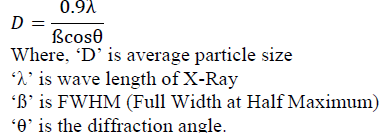 |
| The author concludes that a new method, electrolytic cathode deposition has been applied in Copper Nanopowder preparation and successfully completed the entire process. Based on this study, some other nanopowder may be prepared in future [22]. |
| Use of biodiesel produces engine oil dilution because of unburned biodiesel impinging on cold walls of the combustion chamber, being scrapped to the oil pan, and leading to changes of oil friction, wear and lubricity properties. In this paper, mixtures of SAE 15W-40 oil, which were contaminated by known percentages of the biodiesels from canola oil, peanut oil, soybean oil, and chicken fat, were tested in a pin-on-disk tribometer. A contact was employed of AISI 1018 steel disk and AISI 316 stainless-steel ball for pin material, and friction force and specific wear were measured. Wear on the disk surfaces showed that any degree of mineral oil dilution by the tested biodiesels reduces the wear protection of engine oil even at small mixture percentages. However, these reductions were not substantially different than those observed for same percentages of dilution of mineral oil by fossil diesel. The tested mixture of oil contaminated with animal fat feedstock (e.g., chicken fat) biodiesel showed the best wear behaviour as compared to those for the other tested mixtures (of mineral oil with vegetable feedstock biodiesel dilutions). Obtained results are discussed as baseline for further studies in a renewable energy multidisciplinary approach on biofuels and biolubes [23]. |
EXPERIMENTATION |
| Copper Sulphate and Zinc Sulphate are used as base materials (AR grade). Sodium hydroxide, Triton X100 and Ethyl alcohol used for preparingCuO-ZnOMixed Metal Oxide.Metal Sulphate solution (CuSO4+ZnSO4) of 0.1 Normality is added drop wise to sodium hydroxide solution containing Triton X100 as capping agent which was under continuous stirring with the help of magnetic stirrer. The formed metal hydroxide precipitate is filtered and transferredto the centrifuge which was previously cleaned with Ethyl alcohol and centrifuged at a speed of 3000rpm fora duration of 5mins. The centrifuged precipitate is calcinated at 600oC for 6hrs in Muffle furnace. |
Characterization of CuO-ZnO Mixed Metal Oxide nanoparticles |
| X-Ray Diffraction (XRD) patterns obtained from X-Ray Diffractometer using 1.5406Å wavelength radiation at a scan rate of 0.020s-1 were used to identify composition and the same is used to calculate particle size using Debye– Scherrer equation |
 |
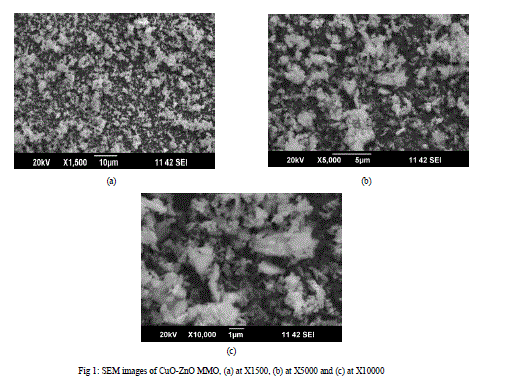 |
| The size of the nanoparticles found to be within 30nm. The morphology of synthesized MMO was studied using Scanning Electron Microscope (SEM) at an accelerating voltage of 20kV. The nano crystal shape found to be snow flaked structure directly from SEM images (Fig 1). The XRD patterns are shown in Fig 2. The elemental analysis was studied using Energy Dispersive Spectrometry (EDS) and found the presence of Zinc, Copper, Oxygen and few percentage of Sulphur (Fig 3). |
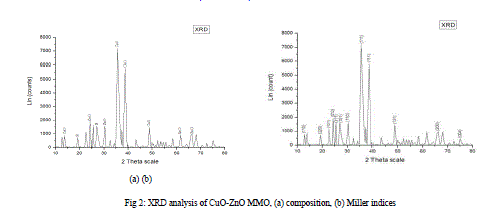 |
Preparation of Nanolubricant |
| The main properties of the MMO nanoparticles, base oil and test specimens used are listed in Table 1. The CuO-ZnO MMO nanoparticles were dispersed in base oil at different concentrations of 0.5%, 1.0% and 2.0%wt using Sonicator for 8 min. The MMO in base oil is uniformly dispersed without any settlement. |
 |
Wear Properties of Nanolubricant in Pin on disc tester |
| The test performed with a pin-on-disk apparatus in ambient temperature. The load is applied to the pin through dead weights. The load cell contacted with the supporting arm measured the value of the friction force imposed on the static pin specimen. The test was performed at a constant load of 19 N, sliding distance of 1000m and for sliding velocity 0.25m/s. Before the test, samples were cleaned with woollen cloth to avoid the entrapment of wear debris and to achieve uniformity in experientialprocedure. The mass loss of specimen was calculated from the difference in the mass measured before and after each test. Wear surfaces on pin were characterised using SEM for WSD. |
RESULTS AND DISCUSSION |
| The Pin on Disc wear test was performed at ambient temperature with drop wise lubrication where Nanolubricant is used. The pin used for the wear test is Al 6061 aluminium alloy of 8mm diameter having density 2.7gm/cc. The results obtained for different nanoparticle concentrations (0%, 0.5%, 1.0% and 2.0%wt) are listed in Table 2. |
 |
| Fig 4 illustrates the effect of nanoparticle concentration in base oil with co-efficient of friction (COF), the COF decreases with increasing nanoparticle concentration in lubricant. However results for each suspension differ depending on nanoparticle concentration. The COF decreases to least value of 0.059 for 1.0%wt concentration and increases to 0.085 at 2.0%wt concentration. The 1.0% CuO-ZnO suspension exhibited the better tribological behaviour. |
| Fig 5 illustrates the effect of nanoparticle concentration in base oil on Wear Loss. The Wear Loss decreases with increasing nanoparticle concentration in the lubricant. In contrast the wear loss is maximum for base oil and minimum for 1.0% CuO-ZnO suspension and remains same with 2.0% of CuO-ZnO. |
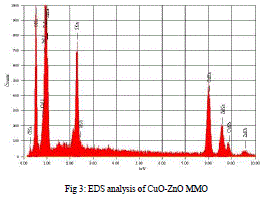 |
| Fig 6 illustrates the effect of nanoparticle concentration in base oil on Wear Scar Diameter (WSD). The WSD decreases with increasing nanoparticle concentration in the lubricant. The WSD of 1.744mm remains maximum for base oil without CuO-ZnO nanoparticle suspension and 0.875mm minimum for 2.0% CuO-ZnO suspension. The SEM images of WSD are shown in Fig 8. |
| The variation of wear with respect to time is shown in Fig 7. It illustrates that the wear of pin decreases with nanoparticle suspension in the oil increases. The wear with respect to time is least for 1.0% CuO-ZnO suspension and increases a little for 2.0% CuO-ZnO suspension but remains well below the base oil without nanoparticle. |
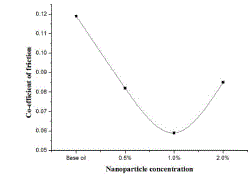 |
CONCLUSION |
| Results obtained from synthesis of nanoparticles and tests conducted on Pin on disc concludes that |
| • All nanoparticles obtained are in the size range of 18 to 30nm by the method of Co-precipitation. |
| • By the method of Co-precipitation CuO-ZnO Mixed Metal Oxide nanoparticle synthesis is achieved with less impurity. |
| • The COF decreases with increase in nanoparticle concentration up to 1.0%wt and again increased for 2.0%wt. Nanoparticles were deposited mainly in the form of film during the friction process, because the surface energy and activity of the nanoparticles became higher as the particle size decreased. With higher concentration of nanoparticles the particles tend to weld and increases the force required to overcome the friction. |
| • The WSD on pin surface decreases with increase in nanoparticle concentration. The WSD is smallest when suspension reached to 2.0%wt. Since the adsorption of pin surface was saturated, the arrangement of molecules was closer and protective film thickened with an increasing content of nanoparticles in base oil. |
| • All concentrations of nanoparticle suspension in base oil (SAE 20W50) improved the wear properties. |
References |
|